You are using an out of date browser. It may not display this or other websites correctly.
You should upgrade or use an alternative browser.
You should upgrade or use an alternative browser.
Colt Bisley question
- Thread starter Quincunx
- Start date
Driftwood Johnson
New member
Howdy
I had to dig out my copy of Kopec's A Study of the Colt Single Action Army Revolver to get you an answer.
There were two slightly different versions of the Bisley Model, the Bisley Target Model, sometimes called the Flat Top version and the Standard Bisley Model.
The first Bisley Target models were shipped to Colt's London agency in May of 1894. These revolvers were designed for the pistol target matches held at the Bisley range outside of London. They were designed purely as target revolvers, meant to compete with the other popular target revolvers of the day, most likely the Smith and Wesson New Model Number Three, which had been setting records since 1878. The Bisley Target model had a drift adjustable rear sight, and an interchangeable pinned front sight insert. The overwhelming majority of Bisley Target models had 7 1/2" barrels. Other barrel lengths were available, there is a photo in Kopec's book of a rare pair of 3 1/2" 'Sheriff Model' Bisley's without ejector rods. The balance of Bisley Target models had the standard 5 1/2" and 4 3/4" barrels.
Since the Bisley Target model was originally designed for the British market, it is not surprising that the most popular caliber was the .455 Eley, followed in order by 32-20, 44 Russian, 38-40, 45 Colt, 38 Colt, 44-40, 38-44 S&W, 32 Colt, 32 S&W, 32-44 S&W, 41 Colt, 38 S&W, and 32 Colt New Police.
These photos of a Bisley Target model are from the Rock Island Auction Company.

Here is a closeup of the rear sight of this Bisley Target model. Notice the Flat Top.
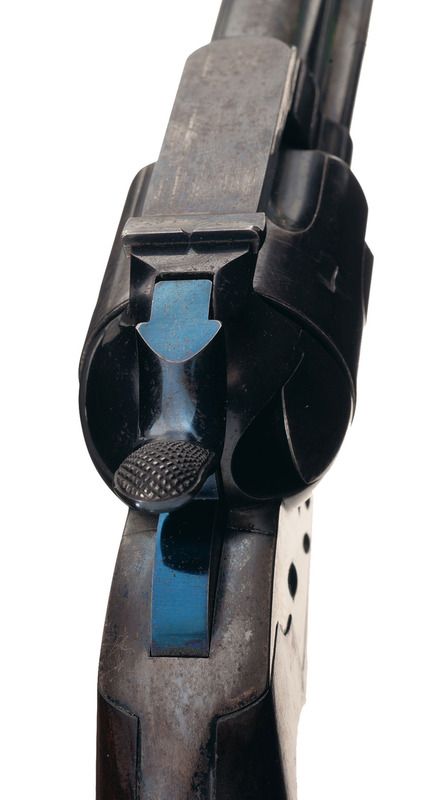
The Standard Bisley Model lacked the adjustable rear sight and had a standard front sight soldered onto the front of the barrel. The Standard Bisley Model lacked the Flat Top, the rear sight being a groove milled into the top strap just like any other Single Action Army.
According to Kopec, 62% of surveyed Standard Bisley models had 4 3/4" barrels, 20% had 5 1/2" barrels, and 18% had 7 1/2" barrels. Kopec notes these are survey percentages of existing Standard Bisley revolvers, not hard numbers from the factory. Kopec also notes that caliber preferences for Standard Bisley models were quite different than for standard Single Action Army revolvers. In descending order of preference, they were 32-20, 38-40, 45 Colt, 44-40, and 41 Colt. Limited production included 38 Colt, 455 Eley, 32 Colt, and 44 Russian.
This 4 3/4" 38-40 Standard Bisley was made in 1909. Thanks for making me look up this information, now I know it is just about the most common configuration of the Standard Bisley model. And the hard rubber grips are standard too.
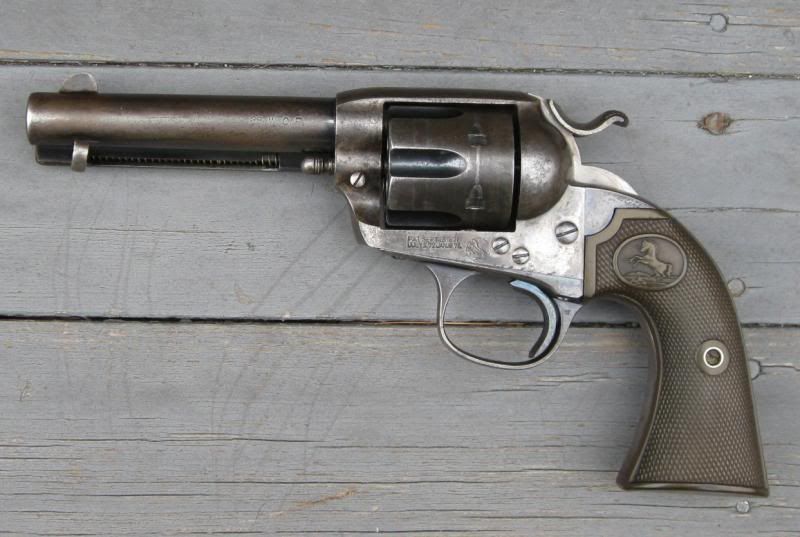
Notice the typical barrel marking. Almost worn away (BISLEY MODEL) followed by the caliber.
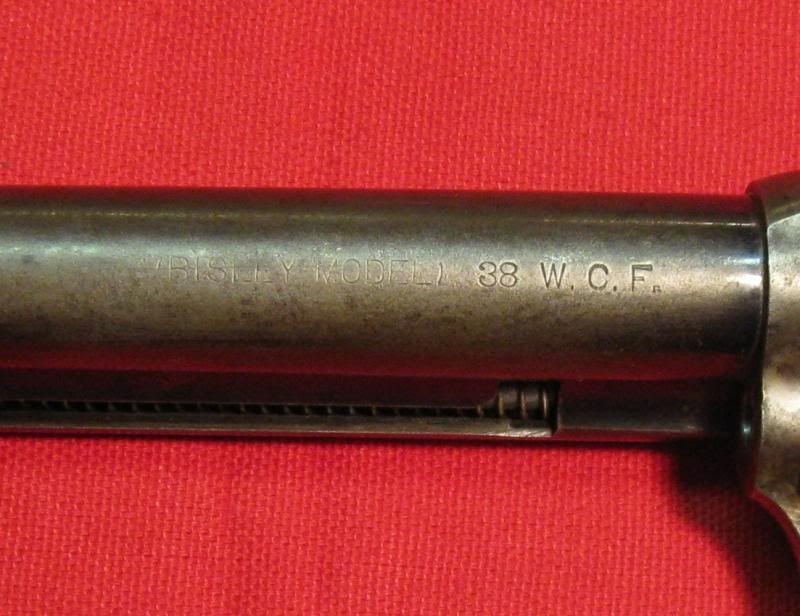
Just for fun, here is a photo of Pancho Villa with his favorite revolver, a Bisley Colt made in 1912.
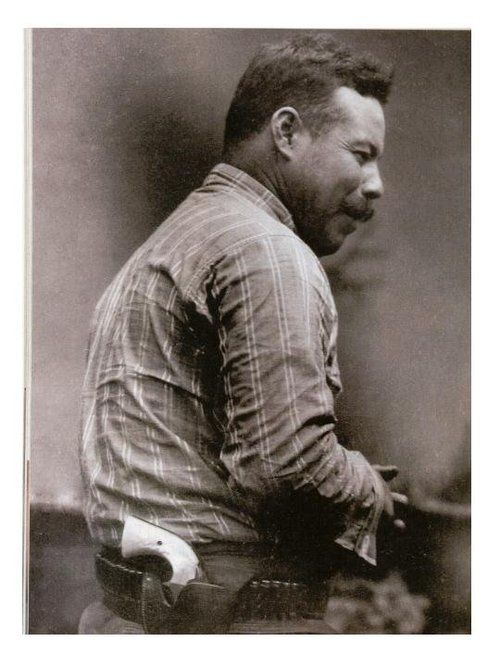
I had to dig out my copy of Kopec's A Study of the Colt Single Action Army Revolver to get you an answer.
There were two slightly different versions of the Bisley Model, the Bisley Target Model, sometimes called the Flat Top version and the Standard Bisley Model.
The first Bisley Target models were shipped to Colt's London agency in May of 1894. These revolvers were designed for the pistol target matches held at the Bisley range outside of London. They were designed purely as target revolvers, meant to compete with the other popular target revolvers of the day, most likely the Smith and Wesson New Model Number Three, which had been setting records since 1878. The Bisley Target model had a drift adjustable rear sight, and an interchangeable pinned front sight insert. The overwhelming majority of Bisley Target models had 7 1/2" barrels. Other barrel lengths were available, there is a photo in Kopec's book of a rare pair of 3 1/2" 'Sheriff Model' Bisley's without ejector rods. The balance of Bisley Target models had the standard 5 1/2" and 4 3/4" barrels.
Since the Bisley Target model was originally designed for the British market, it is not surprising that the most popular caliber was the .455 Eley, followed in order by 32-20, 44 Russian, 38-40, 45 Colt, 38 Colt, 44-40, 38-44 S&W, 32 Colt, 32 S&W, 32-44 S&W, 41 Colt, 38 S&W, and 32 Colt New Police.
These photos of a Bisley Target model are from the Rock Island Auction Company.

Here is a closeup of the rear sight of this Bisley Target model. Notice the Flat Top.

The Standard Bisley Model lacked the adjustable rear sight and had a standard front sight soldered onto the front of the barrel. The Standard Bisley Model lacked the Flat Top, the rear sight being a groove milled into the top strap just like any other Single Action Army.
According to Kopec, 62% of surveyed Standard Bisley models had 4 3/4" barrels, 20% had 5 1/2" barrels, and 18% had 7 1/2" barrels. Kopec notes these are survey percentages of existing Standard Bisley revolvers, not hard numbers from the factory. Kopec also notes that caliber preferences for Standard Bisley models were quite different than for standard Single Action Army revolvers. In descending order of preference, they were 32-20, 38-40, 45 Colt, 44-40, and 41 Colt. Limited production included 38 Colt, 455 Eley, 32 Colt, and 44 Russian.
This 4 3/4" 38-40 Standard Bisley was made in 1909. Thanks for making me look up this information, now I know it is just about the most common configuration of the Standard Bisley model. And the hard rubber grips are standard too.

Notice the typical barrel marking. Almost worn away (BISLEY MODEL) followed by the caliber.

Just for fun, here is a photo of Pancho Villa with his favorite revolver, a Bisley Colt made in 1912.

Last edited:
spacecoast
New member
Some additional info from the Colt Forum -
http://www.coltforum.com/forums/single-action-army/91269-1st-gen-saa-bisley-production-caliber.html
Most common Bisley calibers and production:
.32-20 = 13,291
.38-40 = 12,162
.45 Colt = 8,005
.44-40 = 6,803
.41 Colt = 3,159
Same data (inferred) for the SAA:
.45 Colt = 150,879
.44 WCF = 64,589 (.44-40)
.38 WCF = 38,358 (.38-40)
.32 WCF = 29,993 (.32-20)
.41 Colt = 16,517
As you can see from the numbers, the Bisley was much more about target shooting and less about general purpose use as compared to the SAA.
My Bisley is a .44-40 with 4-3/4" barrel, shipped in Dec. 1900. It shoots great.
http://www.coltforum.com/forums/single-action-army/91269-1st-gen-saa-bisley-production-caliber.html
Most common Bisley calibers and production:
.32-20 = 13,291
.38-40 = 12,162
.45 Colt = 8,005
.44-40 = 6,803
.41 Colt = 3,159
Same data (inferred) for the SAA:
.45 Colt = 150,879
.44 WCF = 64,589 (.44-40)
.38 WCF = 38,358 (.38-40)
.32 WCF = 29,993 (.32-20)
.41 Colt = 16,517
As you can see from the numbers, the Bisley was much more about target shooting and less about general purpose use as compared to the SAA.
My Bisley is a .44-40 with 4-3/4" barrel, shipped in Dec. 1900. It shoots great.
Attachments
Driftwood Johnson
New member
As you can see from the numbers, the Bisley was much more about target shooting and less about general purpose use as compared to the SAA.
Howdy Again
I will have to disagree with you somewhat on that statement.
There were only a total of 976 Bisley Target models made.
There were 44,350 of the Standard Bisley models made.
The Target Models were clearly designed for target shooting, indeed the Target Model Bisley, which preceded the Standard Bisley model by a year or so, was a further development of the rare Standard Frame Target Model of 1888. There were less than 1000 Standard Frame Target Models made. These too had the drift adjustable rear sight and the interchangeable blade front sight.
When the Bisley Target model appeared in 1894 it had further refinements that the Standard Frame Target model did not have. Chief among these was the redesigned grip frame, trigger, and hammer. Kopec describes how target shooters in the late 19th Century came to prefer the grip shape of the Bisley model to the standard plow handle grip because unlike the plow handle grip, the Bisley grip did not tend to rotate in the hand from recoil. It instead tended to recoil straight back. Although this transferred more recoil energy to the hand, it meant that the shooter's grip was not disturbed by recoil, an attribute prized by target shooters. The lowered hammer spur profile allowed the shooter to cock the hammer with less disturbance to gripping the revolver too.
Internally, in addition to he new external hammer shape the Bisley Hammer incorporated a T shaped stirrup to receive the end of the main spring. This was different than the roller on the hammer of the standard SAA. The design change was meant to lessen the force needed to cock the hammer, another attribute the target shooter would appreciate.

This photo shows the arrangement of the hammer spring and the T shaped stirrup on the hammer.

All of this would tend to agree with the statement that the Bisley Colt was more about target shooting than general use. But I say again, there were less than 1000 Bisley Target models made.
Here are some production numbers that disagree slightly with the statistics quoted by spacecoast. The source of these numbers is Kuhnhausen's Colt Single Action Revolvers, a Shop Manual, Volumes 1 & 2.
Bisley Target Model:
455 Eley - 196
32-20 - 131
38-40 - 98
45 Colt - 97
38 Colt - 96
44-40 - 78
44 S&W - 64
44 Russian - 62
38-44 S&W - 47
32 Colt - 44
41 Colt - 24
32 S&W - 17
32-44 S&W - 17
38 S&W - 5
Standard Bisley Model:
32-20 - 13,291
38-40 - 12,163
45 Colt - 8,005
44-40 - 6,803
41 Colt - 3,159
38 Colt - 412
455 Eley - 180
32 Colt - 160
44 Russian - 90
44 S&W - 29
32 S&W - 18
32-44 S&W - 14
38 S&W - 10
38-44 S&W - 6
450 Eley - 5
38 S&W Special - 2
45 Smooth Bore - 2
44 Smooth Bore - 1
But if we look at my figures from the previous post, 62% of the Standard Model Bisley Colts had 4 3/4" barrels. I respectfully submit that very few serious late 19th Century target shooters would have been using a Bisley Colt with fixed sights and a 4 3/4" barrel. The overwhelming majority of the Bisley Target models had 7 1/2" barrels.
Kopec makes another interesting observation. He states that a survey of Colt records shows that some Mid Westerners and South Westerners preferred the Bisley Model, and he has compiled an impressive list of individuals and mining companies that had Bisley models shipped to them.
He concludes with this statement:
"It is obvious that Colt's Bisley Model had among its devotees men who knew revolvers well and relied on them in their everyday existences."
I know that when I shoot CAS with that old Bisley of mine, I feel much more like a lawman or desperado shooting it out than a sophisticated late 19th Century target shooter.
spacecoast
New member
Driftwood -
My statement was based purely on caliber, not on any more detailed analysis. Thanks for all the good info.
My statement was based purely on caliber, not on any more detailed analysis. Thanks for all the good info.
FWIW, the Bisley was something of a desperation move by Colt. In the late 19th century, target shooting was all the rage, with the best shots being treated as celebrities like top NASCAR drivers or PGA champs today. And in pistol (actually revolver or single shot - there were no autoloaders) shooting, the matches were being won with guns from Springfield, Mass. Colt wanted a piece of that action. Target guns, then and now, were a relatively small portion of sales, but the PR value of an endorsement by a top shooter was enormous.
So Colt, tired of watching S&W get the headlines, decided to get into the target game and turned to its old standby, the Single Action Army. The SAA itself had never been intended as a target gun, but Colt got advice from some top shooters, and managed to turn the old warhorse into something approaching a target revolver, which they named after the famous English firing range. It never had the trigger pull or the fitting that characterized the New Model No. 3 from Springfield, but it was good enough to win some matches and help assuage Colt's hurt feelings.
Jim
So Colt, tired of watching S&W get the headlines, decided to get into the target game and turned to its old standby, the Single Action Army. The SAA itself had never been intended as a target gun, but Colt got advice from some top shooters, and managed to turn the old warhorse into something approaching a target revolver, which they named after the famous English firing range. It never had the trigger pull or the fitting that characterized the New Model No. 3 from Springfield, but it was good enough to win some matches and help assuage Colt's hurt feelings.
Jim
Jim Watson
New member
The Bisley Target model had a drift adjustable rear sight, and an interchangeable pinned front sight insert.
Don't say that too loudly, British match rules of the day did not allow adjustable sights.
Just FWIW, that .38-44 mentioned is the old .38-44 S&W, a cartridge made specifically for target shooting. It (and its companion .32-44, also mentioned) had wadcutter bullets seated flush with the case mouth, and had extra long cases to minimize bullet "jump" to the barrel. The case diameters were the same as those of the .32 S&W and .38 S&W. Both cartridges were popular for target shooting at the time.
The later .38-44, put out for use with the S&W .38-44 Heavy Duty revolver in 1930, was simply a hot loaded .38 Special. It is usually considered to be the "father" of the .357 Magnum.
Jim
The later .38-44, put out for use with the S&W .38-44 Heavy Duty revolver in 1930, was simply a hot loaded .38 Special. It is usually considered to be the "father" of the .357 Magnum.
Jim
Jim Watson
New member
Pictures of period .38-44 Target ammo I looked at while I was loading for a No 3 NM Target had a round nose bullet seated below the case mouth.
So that was what I did.
.32-44 S&W Target was not a cylinder length case, but the bullet was still seated submerged.
The .38-44 was developed at the behest of Ira Paine and the .32-44 for the Bennett brothers, all looking for lighter recoil.
Paine went back to the .44 Russian, though.
Stebbins said that the gallery load with a round ball and 5 gr of black was dirty shooting and not very accurate.
So that was what I did.
.32-44 S&W Target was not a cylinder length case, but the bullet was still seated submerged.
The .38-44 was developed at the behest of Ira Paine and the .32-44 for the Bennett brothers, all looking for lighter recoil.
Paine went back to the .44 Russian, though.
Stebbins said that the gallery load with a round ball and 5 gr of black was dirty shooting and not very accurate.
Driftwood Johnson
New member
Howdy Again
Here is a page from a reprint of a S&W catalog from about 1900. The 32-44 and 38-44 cartridges, and their descriptions are the first two on the upper left.
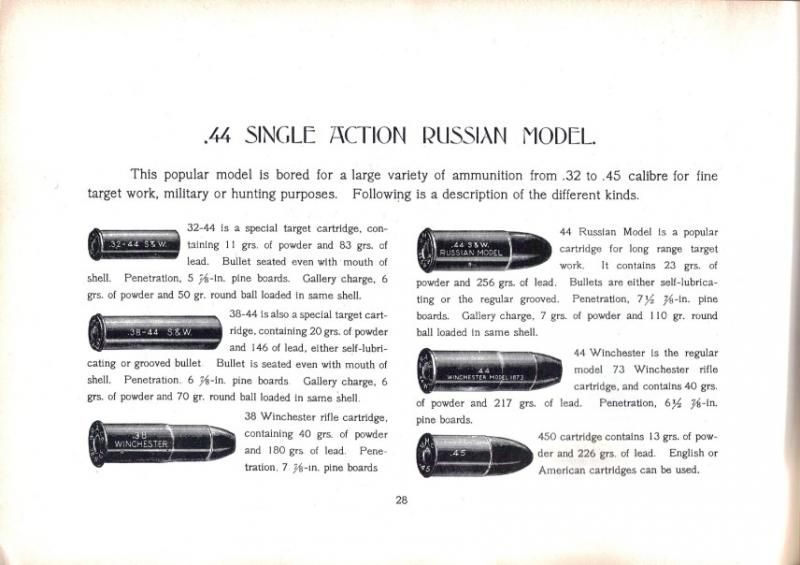
And here is the catalog page of the revolver that fired them. This is the revolver that the Bisley model was competing against. Note that in this catalog this revolver is called the Russian Model. This is not the revolver we know as the Russian Model today, today we call it the New Model Number Three. The New Model #3 was a more sophisticated revolver than the Russian model, the grip was easier to hold, and it had a rebounding hammer. This catalog probably called it the Russian Model because the most common chambering for it was 44 Russian. Note that the revolver pictured is not a target model, this is a standard model. The target model New Model #3 had a different front sight, and the rear sight was adjustable for windage.
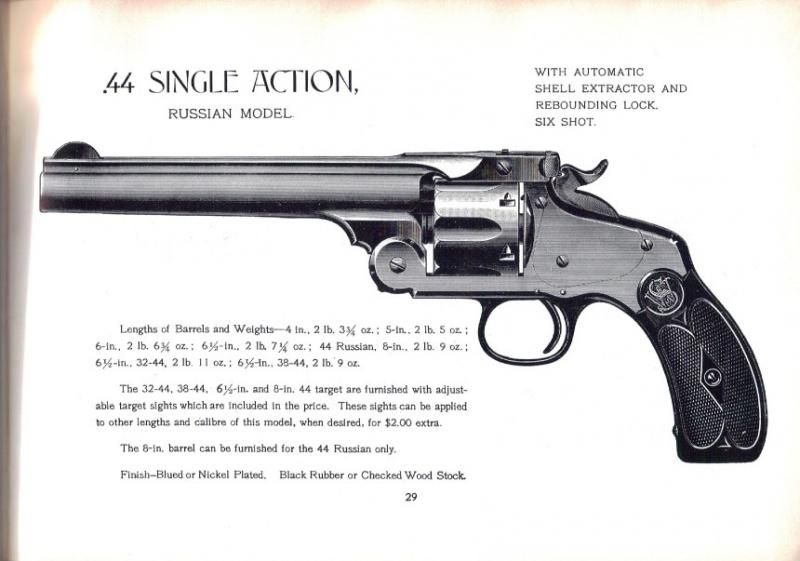
This is my New Model Number Three. It shipped in 1882, but it looks so terrific because it was refinished at the factory in 1965. This one is also not a target model, it has the standard sights, and it is chambered for 44 Russian.

This is a typical S&W target front sight. This particular sight is on a S&W Double Action 44 Target Model. This is the same front sight most often seen on the New Model #3 Target Models.

This is the rear sight on the same Double Action Target Model. It is built into the Top Break latch. The two 'ears' in front of the sight make up the standard, non adjustable sight. The adjustable sight blade and front sight are high enough that the two ears cannot be seen when sighting the gun. The sight is adjustable for windage by loosening the two screws and sliding the blade to one side or the other, then the screws are tightened again to secure the blade. No adjustment for elevation. This is the same adjustable rear sight that would be on a New Model #3 Target Model.

And just so we are clear, this is a Russian Model. Note the radically different grip shape and the much longer ejector housing under the barrel. And of course, the spur under the trigger guard. Although sometimes the same sort of spur on the trigger guard was incorporated in the New Model #3, particularly the ones made for the Turkish contracts. This one was made in 1875, and of course it is chambered for the 44 Russian cartridge. And it is a terrible target gun. That big hump on the grip frame makes cocking the hammer without repositioning the hand almost impossible. And if you happen to fire it with your palm against the point, it hurts when the gun recoils.
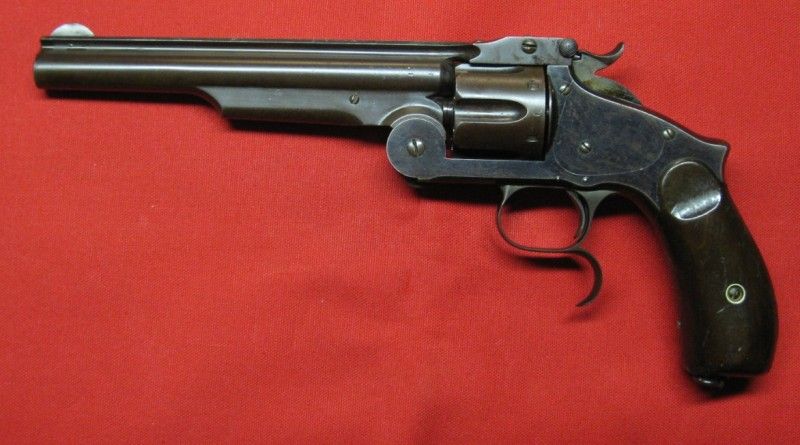
Here is a page from a reprint of a S&W catalog from about 1900. The 32-44 and 38-44 cartridges, and their descriptions are the first two on the upper left.

And here is the catalog page of the revolver that fired them. This is the revolver that the Bisley model was competing against. Note that in this catalog this revolver is called the Russian Model. This is not the revolver we know as the Russian Model today, today we call it the New Model Number Three. The New Model #3 was a more sophisticated revolver than the Russian model, the grip was easier to hold, and it had a rebounding hammer. This catalog probably called it the Russian Model because the most common chambering for it was 44 Russian. Note that the revolver pictured is not a target model, this is a standard model. The target model New Model #3 had a different front sight, and the rear sight was adjustable for windage.

This is my New Model Number Three. It shipped in 1882, but it looks so terrific because it was refinished at the factory in 1965. This one is also not a target model, it has the standard sights, and it is chambered for 44 Russian.

This is a typical S&W target front sight. This particular sight is on a S&W Double Action 44 Target Model. This is the same front sight most often seen on the New Model #3 Target Models.

This is the rear sight on the same Double Action Target Model. It is built into the Top Break latch. The two 'ears' in front of the sight make up the standard, non adjustable sight. The adjustable sight blade and front sight are high enough that the two ears cannot be seen when sighting the gun. The sight is adjustable for windage by loosening the two screws and sliding the blade to one side or the other, then the screws are tightened again to secure the blade. No adjustment for elevation. This is the same adjustable rear sight that would be on a New Model #3 Target Model.

And just so we are clear, this is a Russian Model. Note the radically different grip shape and the much longer ejector housing under the barrel. And of course, the spur under the trigger guard. Although sometimes the same sort of spur on the trigger guard was incorporated in the New Model #3, particularly the ones made for the Turkish contracts. This one was made in 1875, and of course it is chambered for the 44 Russian cartridge. And it is a terrible target gun. That big hump on the grip frame makes cocking the hammer without repositioning the hand almost impossible. And if you happen to fire it with your palm against the point, it hurts when the gun recoils.


